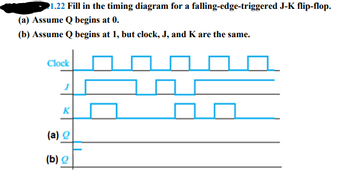
Introductory Circuit Analysis (13th Edition)
13th Edition
ISBN: 9780133923605
Author: Robert L. Boylestad
Publisher: PEARSON
expand_more
expand_more
format_list_bulleted
Concept explainers
Question

Transcribed Image Text:### Timing Diagram for a Falling-Edge-Triggered J-K Flip-Flop
This diagram helps illustrate the behavior of a J-K flip-flop based on given clock, J, and K input signals. The J-K flip-flop is a type of digital storage element that can act as a memory for one bit of information.
#### Components of the Diagram:
1. **Clock Signal**:
- The clock line shows a series of square pulses. The transitions from high to low represent the falling edges, which are the triggering events for the J-K flip-flop.
2. **J Signal**:
- The J line indicates when the J input is high or low. This signal determines how the flip-flop should behave on the falling edge of the clock signal.
3. **K Signal**:
- The K line shows when the K input is high or low. Similar to the J input, it influences the state of the flip-flop on the clock's falling edge.
4. **Q Output** (for parts a and b):
- Two scenarios are tested for the Q output, depending on the initial state of Q.
- **Scenario (a)**: Q begins at 0.
- **Scenario (b)**: Q begins at 1.
- For each clock falling edge, the Q output is updated based on the states of J and K according to the J-K flip-flop truth table.
#### Explanation:
- **State Transitions**:
- On the falling edge of the clock, the state of Q changes depending on the inputs J and K:
- **J = 0, K = 0**: No change.
- **J = 0, K = 1**: Reset Q to 0.
- **J = 1, K = 0**: Set Q to 1.
- **J = 1, K = 1**: Toggle Q.
This diagram effectively guides students to understand how the J-K flip-flop changes state concerning the clock edge and the input signals. Filling out the Q lines for each scenario will reinforce understanding of synchronous sequential logic.
Expert Solution
This question has been solved!
Explore an expertly crafted, step-by-step solution for a thorough understanding of key concepts.
This is a popular solution
Trending nowThis is a popular solution!
Step by stepSolved in 2 steps with 2 images

Knowledge Booster
Learn more about
Need a deep-dive on the concept behind this application? Look no further. Learn more about this topic, electrical-engineering and related others by exploring similar questions and additional content below.Similar questions
- Find Q and Q bar for given flip flop and timing diagram JSQ Clock J Karrow_forwardQ1. a) Given the State Diagram of Figure 1, draw and complete the state, transition, and output tables, assuming an implementation with JK Flip- Flops. X=0 S₁/1 S₂/0 X=1 S₂/1 S₂/1 Figure 1: State Diagram for Question 1a 0arrow_forward1) The following waveform are applied to the J-K flip flop with negative edge clock pulse. Assuming the flip flop is initially set, determine the Q output. (a) 2) Repeat question 1 for positive edge clock pulse.arrow_forward
- Figure 2.1 shows the Asynchronous J-K flip flop and it truth table. Draw an output waveform, Q by drag and drop the correct waveform. Q is initially LOW. Clock Preset Clear Input J Input K Output J CLK K PRESET a Q CLEAR PRESET 1 0 CLEAR 1 1 0 0 Figure 2.1 FF response Clocked operation" Q1 (regardless of CLK) Q=0 (regardless of CLK) Not used 0 *Q will respond to J, K, and CLKarrow_forwardcheck the image for questionarrow_forward1. Explain the set and clear functions on the JK Flip-flop!arrow_forward
- question in picture pleasearrow_forwardRemaining Time: 56 minutes, 03 seconds. A Question Completion Status: 3 70 80 A Moving to another question will save this response. Question 5 Design a counter with the count sequence 0, 1, 2, 4, 5, 6 using JK flip-flops. Fill in the following table for the required counter PS NS Flip-flop Input ABCABC JA KA JB KB JC KC 000 10 0010010 0 100100 100100X 101101X X X 1. 1 1 10000Xarrow_forwardFill in the timing diagram for a falling-edge-triggered J-K flip-flop. Assume Q begins at 0. Clock K Garrow_forward
arrow_back_ios
arrow_forward_ios
Recommended textbooks for you
 Introductory Circuit Analysis (13th Edition)Electrical EngineeringISBN:9780133923605Author:Robert L. BoylestadPublisher:PEARSON
Introductory Circuit Analysis (13th Edition)Electrical EngineeringISBN:9780133923605Author:Robert L. BoylestadPublisher:PEARSON Delmar's Standard Textbook Of ElectricityElectrical EngineeringISBN:9781337900348Author:Stephen L. HermanPublisher:Cengage Learning
Delmar's Standard Textbook Of ElectricityElectrical EngineeringISBN:9781337900348Author:Stephen L. HermanPublisher:Cengage Learning Programmable Logic ControllersElectrical EngineeringISBN:9780073373843Author:Frank D. PetruzellaPublisher:McGraw-Hill Education
Programmable Logic ControllersElectrical EngineeringISBN:9780073373843Author:Frank D. PetruzellaPublisher:McGraw-Hill Education Fundamentals of Electric CircuitsElectrical EngineeringISBN:9780078028229Author:Charles K Alexander, Matthew SadikuPublisher:McGraw-Hill Education
Fundamentals of Electric CircuitsElectrical EngineeringISBN:9780078028229Author:Charles K Alexander, Matthew SadikuPublisher:McGraw-Hill Education Electric Circuits. (11th Edition)Electrical EngineeringISBN:9780134746968Author:James W. Nilsson, Susan RiedelPublisher:PEARSON
Electric Circuits. (11th Edition)Electrical EngineeringISBN:9780134746968Author:James W. Nilsson, Susan RiedelPublisher:PEARSON Engineering ElectromagneticsElectrical EngineeringISBN:9780078028151Author:Hayt, William H. (william Hart), Jr, BUCK, John A.Publisher:Mcgraw-hill Education,
Engineering ElectromagneticsElectrical EngineeringISBN:9780078028151Author:Hayt, William H. (william Hart), Jr, BUCK, John A.Publisher:Mcgraw-hill Education,

Introductory Circuit Analysis (13th Edition)
Electrical Engineering
ISBN:9780133923605
Author:Robert L. Boylestad
Publisher:PEARSON

Delmar's Standard Textbook Of Electricity
Electrical Engineering
ISBN:9781337900348
Author:Stephen L. Herman
Publisher:Cengage Learning

Programmable Logic Controllers
Electrical Engineering
ISBN:9780073373843
Author:Frank D. Petruzella
Publisher:McGraw-Hill Education

Fundamentals of Electric Circuits
Electrical Engineering
ISBN:9780078028229
Author:Charles K Alexander, Matthew Sadiku
Publisher:McGraw-Hill Education

Electric Circuits. (11th Edition)
Electrical Engineering
ISBN:9780134746968
Author:James W. Nilsson, Susan Riedel
Publisher:PEARSON

Engineering Electromagnetics
Electrical Engineering
ISBN:9780078028151
Author:Hayt, William H. (william Hart), Jr, BUCK, John A.
Publisher:Mcgraw-hill Education,